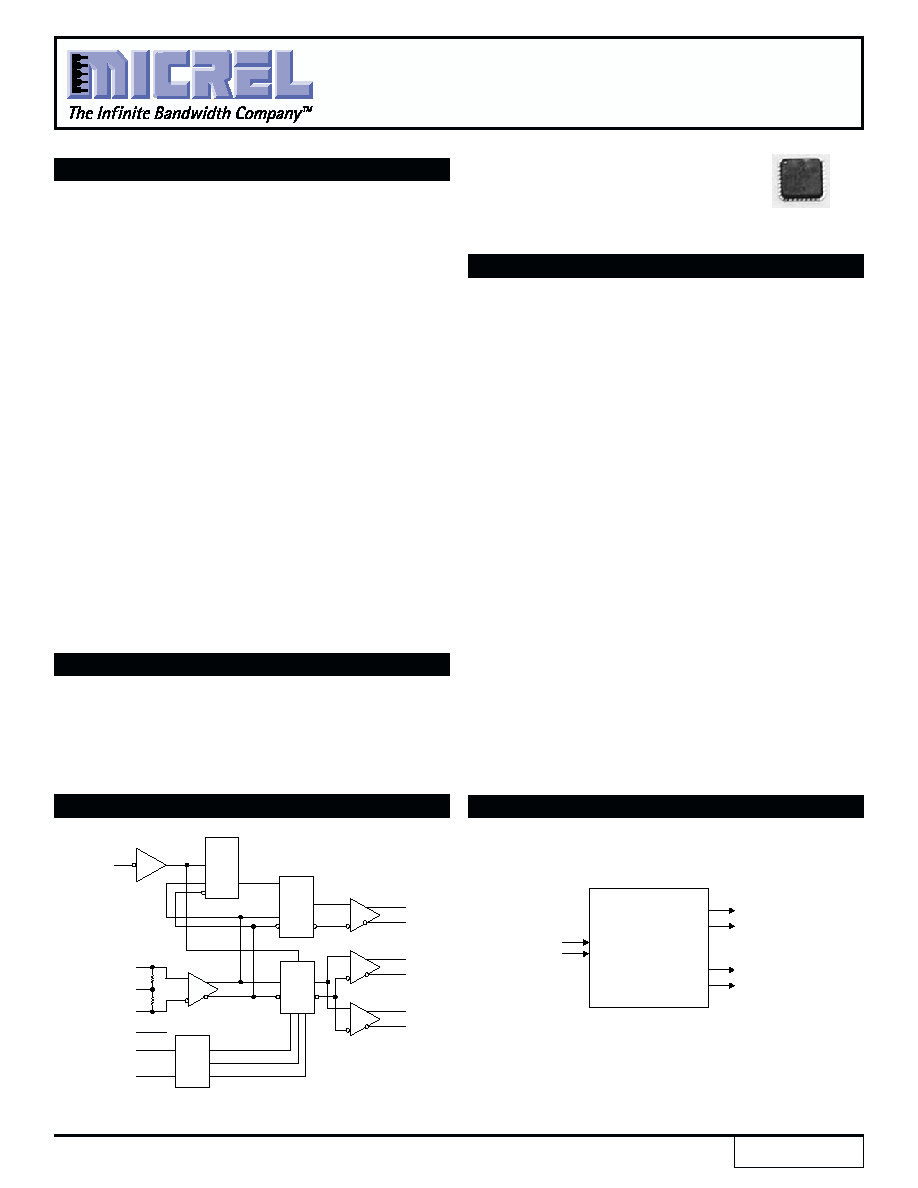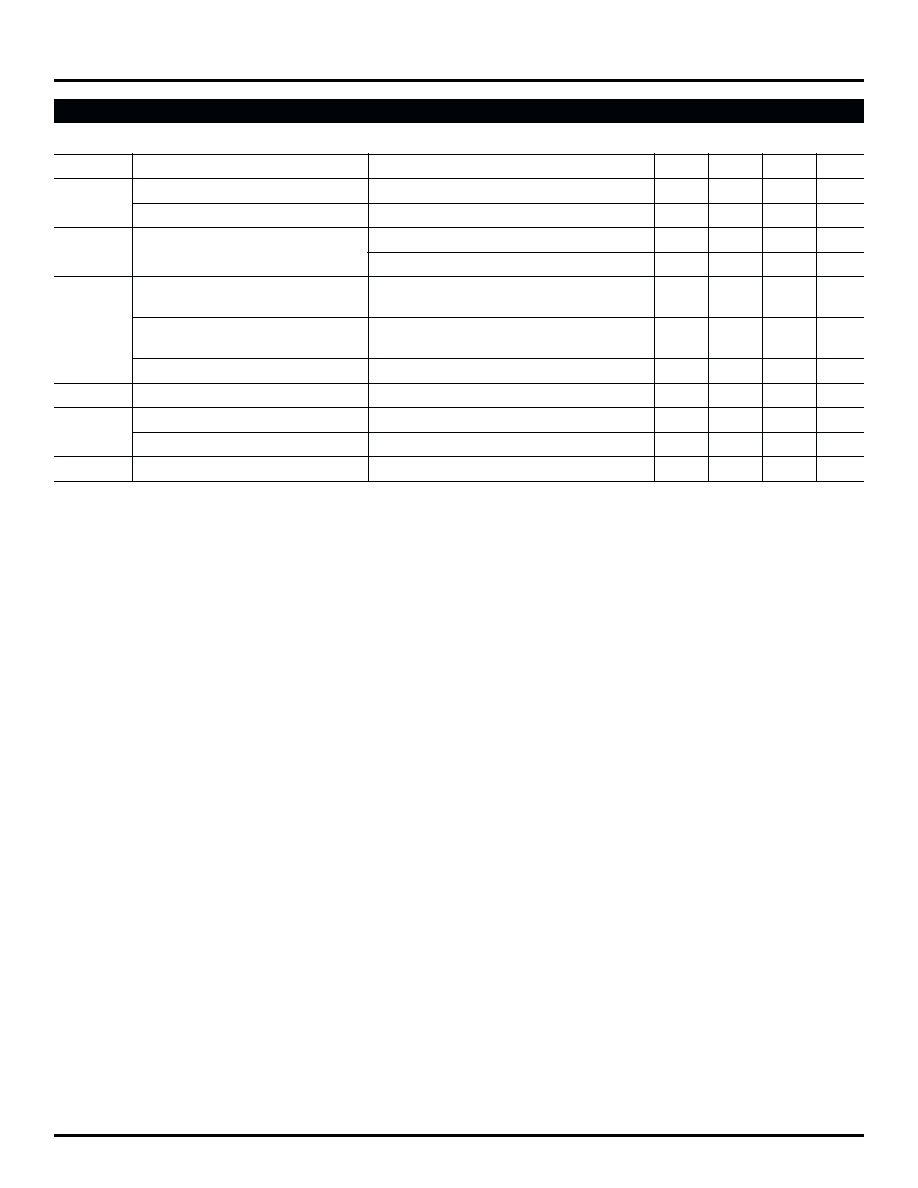 | –≠–ª–µ–∫—Ç—Ä–æ–Ω–Ω—ã–π –∫–æ–º–ø–æ–Ω–µ–Ω—Ç: SY89872U | –°–∫–∞—á–∞—Ç—å:  PDF PDF  ZIP ZIP |

DESCRIPTION
I Guaranteed AC performance over temperature and
voltage:
∑ >2GHz F
MAX
∑ < 750ps T
pd
(matched delay between banks)
∑ < 15ps within-device skew
∑ < 200ps rise/fall time
I Low jitter design
∑ < 1ps (rms) cycle-to-cycle jitter
∑ < 10ps (pk-pk) total jitter
I Unique input termination and V
T
pin for DC-coupled
and AC-coupled inputs: any differential inputs
(LVPECL, LVDS, CML, HSTL)
I Precision differential LVDS outputs
I Matched delay: all outputs have matched delay,
independent of divider setting
I TTL/CMOS inputs for select and reset/disable
I Two output banks (matched delay)
∑ Bank A: Buffered copy of input clock (undivided)
∑ Bank B: Divided output (
˜
2,
˜
4,
˜
8,
˜
16),
two copies
I 2.5V power supply
I Wide operating temperature range: ≠40
∞
C to +85
∞
C
I Available in 16-pin (3mm
◊ 3mm) MLFTM package
FEATURES
2.5V, 2GHz ANY DIFF. IN-TO-LVDS
PROGRAMMABLE CLOCK DIVIDER/FANOUT
BUFFER WITH INTERNAL TERMINATION
Precision EdgeTM
SY89872U
FINAL
APPLICATIONS
I OC-3 to OC-192 SONET/SDH applications
I Transponders
I Oscillators
I SONET/SDH line cards
1
Rev.: B
Amendment: /1
Issue Date:
February 2003
This 2.5V low-skew, low-jitter, precision LVDS output clock
divider accepts any high-speed differential clock input (AC
or DC-coupled) CML, LVPECL, HSTL or LVDS and divides
down the frequency using a programmable divider ratio to
create a frequency-locked, lower speed version of the input
clock. The SY89872U includes two output banks. Bank A is
an exact copy of the input clock (pass through) with matched
propagation delay to Bank B, the divided output bank.
Available divider ratios are 2, 4, 8 and 16. In a typical
622MHz clock system this would provide availability of
311MHz, 155MHz, 77MHz or 38MHz auxiliary clock
components.
The differential input buffer has a unique internal
termination design that allows access to the termination
network through a V
T
pin. This feature allows the device to
easily interface to different logic standards. A V
REF-AC
reference is included for AC-coupled applications.
The SY89872U is part of Micrel's high-speed Precision
EdgeTM timing and distribution family. For 3.3V applications,
consider the SY89873L. For applications that require an
LVPECL output, consider the SY89872U.
The /RESET input asynchronously resets the divider
outputs (Bank B). In the pass-through function (Bank A) the
/RESET synchronously enables or disables the outputs on
the next falling edge of IN (rising edge of /IN). Refer to the
"Timing Diagram."
FUNCTIONAL BLOCK DIAGRAM
TYPICAL APPLICATION
Precision Edge is a trademark of Micrel, Inc.
MicroLeadFrame and MLF are trademarks of Amkor Technology, Inc.
IN
/IN
S1
S0
QB1
/QB1
QB0
/QB0
QA
/QA
/RESET,
/DISABLE
V
T
Divided
by
2, 4, 8
or 16
Decoder
Enable
FF
Enable
MUX
50
50
V
REF-AC
IN
/IN
OC-12 or OC-3
Clock Generator
622MHz LVPECL
Clock In
/QB
QB
/QA
QA
622MHz/155.5MHz
SONET Clock Generator
622MHz LVDS
Clock Out
155.5MHz LVDS
Clock Out
Bank A: 622MHz for OC-12 line card
Bank B: 155.5MHz for OC-3 line card (set to divide-by-4)
Precision EdgeTM

2
Precision EdgeTM
SY89872U
Micrel
Pin Number
Pin Name
Pin Function
1, 2, 3, 4
QB0, /QB0
Differential LVDS Compatible Outputs: Divide by 2, 4, 8, 16.
QB1, /QB1
Unused outputs must be terminated with 100
across the pin (Q, /Q).
5, 6
QA, /QA
Differential LVDS Compatible Undivided Output Clock.
7, 14
VCC
Positive Power Supply: Bypass with 0.1
µF/0.01µF low ESR capacitors.
8
/RESET, /DISABLE
Output Reset and Output Enable/Disable: Internal 25k
pull-up. Input threshold is V
CC
/2.
Logic LOW will reset the divider select, and align Bank A and Bank B edges. In addition, when
LOW, Bank A and Bank B will be disabled.
12, 9
IN, /IN
Differential Reference Input Clock: Internal 50
termination resistors to V
T
input.
See "Input Interface Applications" section.
10
VREF-AC
Reference Voltage: Equal to V
CC
≠1.4V (approx.), and used for AC-coupled applications.
Maximum sink/source current is 0.5mA. See "Input Interface Applications" section.
11
VT
Termination Center-Tap: For DC-coupled CML and LVDS inputs, leave this pin floating. See
"Input Interface Applications" section.
13
GND
Ground.
15, 16
S1, S0
Select Pins: LVTTL/CMOS logic levels. Internal 25k
pull-up resistor. Logic HIGH if left
unconnected (divided by 16 mode). S0 = LSB. Input threshold is V
CC
/2.
PIN DESCRIPTION
/RESET
/DISABLE
S1
S0
Bank A Output
Bank B Outputs
1
0
0
Input Clock
Input Clock
˜2
1
0
1
Input Clock
Input Clock
˜4
1
1
0
Input Clock
Input Clock
˜8
1
1
1
Input Clock
Input Clock
˜16
0
X
X
QA = Low, /QA = High
(1)
QB0 = Low, /QB0 = High
(2)
QB1 = Low, /QB1 = High
(2)
TRUTH TABLE
Note 1. On the next negative transition of the input signal.
Note 2. Asynchronous reset/disable function. (See "Timing Diagram")
PACKAGE/ORDERING INFORMATION
Ordering Information
Package
Operating
Package
Part Number
Type
Range
Marking
SY89872UMI
MLF-16
Industrial
872U
SY89872UMITR*
MLF-16
Industrial
872U
*Tape and Reel
1
2
3
4
12
11
10
9
16 15 14 13
5
6
7
8
QB0
/QB0
QB1
/QB1
IN
VT
VREF-AC
/IN
GND
VCC
S1
S0
/RESET
,
/DISABLE
VCC
/QA
QA
16-Pin MLFTM (MLF-16)

3
Precision EdgeTM
SY89872U
Micrel
Absolute Maximum Ratings
(Note 1)
Supply Voltage (V
CC
) .................................. ≠0.5V to +6.0V
Input Voltage (V
IN
) ......................................... ≠0.5V to V
CC
LVDS Output Current (I
OUT
) ....................................
±10mA
Input Current IN,
/IN (I
IN
) ..........................................
±50mA
V
REF-AC
Input Sink/Source Current (I
VREF-AC
),Note 3 .
±2mA
Lead Temperature (soldering, 10sec.) ...................... 220
∞C
Storage Temperature (T
S
) ....................... ≠65
∞C to +150∞C
Operating Ratings
(Note 2)
Supply Voltage Range ............................ 2.375V to 2.625V
Ambient Temperature (T
A
) ......................... ≠40
∞C to +85∞C
Package Thermal Resistance
MLFTM
(
JA
)
Still-Air ............................................................. 60
∞C/W
500lfpm ............................................................ 54
∞C/W
MLFTM
(
JB
), Note 4
Junction-to-Board ............................................ 32
∞C/W
T
A
= ≠40
∞C to +85∞C; Unless otherwise stated.
Symbol
Parameter
Condition
Min
Typ
Max
Units
V
CC
Power Supply Voltage
2.375
2.5
2.625
V
I
CC
Power Supply Current
No load, max. V
CC
75
110
mA
R
IN
Differential Input Resistance
80
100
120
IN, /IN
V
IH
Input High Voltage
Note 3
0.1
V
CC
+0.3
V
IN, /IN
V
IL
Input Low Voltage
Note 3
≠0.3
V
CC
+0.2
V
IN, /IN
V
IN
Input Voltage Swing
Notes 3, 4
0.1
3.6
V
V
DIFF_IN
Differential Input Voltage Swing
Notes 3, 4, 5
0.2
V
|I
IN
|
Input Current
Note 3
45
mA
IN, /IN
V
REF-AC
Reference Voltage
Note 6
V
CC
≠1.525 V
CC
≠1.425 V
CC
≠1.325
V
Note 1.
The circuit is designed to meet the DC specifications shown in the above table after thermal equilibrium has been established.
Note 2.
Specification for packaged product only.
Note 3.
Due to the internal termination (see
"Input Buffer Structure" section) the input current depends on the applied voltages at IN, /IN and V
T
inputs.
Do not apply a combination of voltages that causes the input current to exceed the maximum limit!
Note 4.
See "Timing Diagram" for V
IN
definition. V
IN
(max.) is specified when V
T
is floating.
Note 5.
See Figures 1c and 1d for V
DIFF
definition.
Note 6.
Operating using V
IN
is limited to AC-coupled PECL or CML applications only. Connect directly to V
T
pin.
DC ELECTRICAL CHARACTERISTICS
(Note 1, 2)
Note 1.
Permanent device damage may occur if ABSOLUTE MAXIMUM RATINGS are exceeded. This is a stress rating only and functional operation is
not implied at conditions other than those detailed in the operational sections of this data sheet. Exposure to ABSOLUTE MAXIMUM RATlNG
conditions for extended periods may affect device reliability.
Note 2.
The data sheet limits are not guaranteed if the device is operated beyond the operating ratings.
Note 3.
Due to the limited drive capability use for input of the same package only.
Note 4.
Junction-to-board resistance assumes exposed pad is soldered (or equivalent) to the device's most negative potential on the PCB.

4
Precision EdgeTM
SY89872U
Micrel
V
CC
= 2.5V
±5%; T
A
= ≠40
∞C to +85∞C; Unless otherwise stated.
Symbol
Parameter
Condition
Min
Typ
Max
Units
V
IH
Input HIGH Voltage
2.0
≠
V
CC
V
V
IL
Input LOW Voltage
0
≠
0.8
V
I
IH
Input HIGH Current
≠125
≠
20
µA
I
IL
Input LOW Current
≠
≠
≠300
µA
Note 1.
The circuit is designed to meet the DC specifications shown in the above table after thermal equilibrium has been established.
Note 2.
Specification for packaged product only.
LVTTL/CMOS INPUTS DC ELECTRICAL CHARACTERISTICS
(Note 1, 2)
V
CC
= 2.5V
±5%; T
A
= ≠40
∞C to +85∞C; Unless otherwise stated.
Symbol
Parameter
Condition
Min
Typ
Max
Units
V
OUT
Output Voltage Swing
Note 5
250
350
450
mV
V
OH
Output High Voltage
Note 3
1.475
V
V
OL
Output Low Voltage
Note 3
0.925
V
V
OCM
Output Common Mode Voltage
Note 4
1.125
1.375
V
V
OCM
Change in Common Mode Voltage
≠50
50
mV
Note 1.
The circuit is designed to meet the DC specifications shown in the above table after thermal equilibrium has been established.
Note 2.
Specification for packaged product only.
Note 3.
Measured as per Figure 1a, 100
across Q and /Q outputs.
Note 4.
Measured as per Figure 1b.
Note 5.
See Figure 1c.
LVDS OUTPUTS DC ELECTRICAL CHARACTERISTICS
(Note 1, 2)

5
Precision EdgeTM
SY89872U
Micrel
V
CC
= 2.5V
±5%; T
A
= ≠40
∞C to +85∞C; Unless otherwise stated.
Symbol
Parameter
Condition
Min
Typ
Max
Units
f
MAX
Maximum Toggle Frequency
Output Swing:
200mV
2
GHz
Maximum Input Frequency
Note 3
3.2
GHz
t
PLH
Differential Propagation Delay
Input Swing: <400mV
500
625
750
ps
t
PHL
IN to Q
Input Swing:
400mV
450
575
700
ps
t
SKEW
Within-Device Skew (differential)
Note 4
7
15
ps
(QB0-to-QB1)
Within-Device Skew (differential)
Note 4
12
30
ps
(Bank A-to-Bank B)
Part-to-Part Skew (differential)
Note 4
250
ps
t
rr
Reset Recovery Time
Note 5
600
ps
T
jitter
Cycle-to-Cycle Jitter
Note 6
1
ps(rms)
Total Jitter
Note 7
10
ps(pk-pk)
t
r
, t
f
Rise / Fall Time (20% to 80%)
70
130
200
ps
Note 1.
Measured with 400mV input signal, 50% duty cycle. 100
termination between Q and /Q, unless otherwise stated.
Note 2.
Specification packaged product only.
Note 3.
Bank A (pass-through) maximum frequency is limited by the output stage. Bank B (input-to-output
˜2, ˜4, ˜8, ˜16) can accept an input frequency
>3GHz, while Bank A will be slew rate limited.
Note 4.
Skew is measured between outputs under identical transitions.
Note 5.
See
"Timing Diagram."
Note 6.
Cycle-to-cycle jitter definition: the variation in period between adjacent cycles over a random sample of adjacent cycle pairs. T
jitter_cc
=T
n
≠T
n+1
,
where T is the time between rising edges of the output signal.
Note 7.
Total jitter definition: with an ideal clock input, of frequency
f
MAX
(device), no more than one output edge in 10
12
output edges will deviate by
more than the specified peak-to-peak jitter value.
AC ELECTRICAL CHARACTERISTICS
(Note 1, 2)




